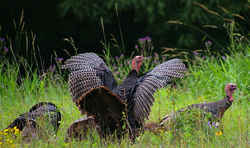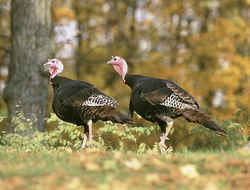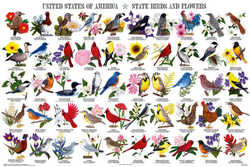Alabama Symbols
Alabama State Game Bird
Wild Turkey

(Meleagris gallopavo)
Adopted on September 6, 1980.
What is the state game bird of Alabama?
The wild turkey (Meleagris gallopavo) was adopted as Alabama official state game bird by Act No. 80-734 of the Alabama Legislature, effective September 6, 1980.
The wild turkey is one of the most common game birds in the United States. The turkey is also one of the most difficult to hunt because of its craftiness and very timid nature.
Long before Europeans came to America, the Aztecs had domesticated turkeys. They used them for food, for religious sacrifices and the feathers for decoration. The Alabama Game and Fish Division of the Department of Conservation and Natural Resources established a wild turkey restocking program in the 1940s to compensate for a turkey shortage caused by over-hunting. Now, Alabama has one of the largest per acre populations of wild turkeys of any state in the United States.
Did you know that: The Wild Turkey has been proclaimed the official state game bird in each of the following states
Alabama | Massachusetts | Oklahoma | South Carolina
Alabama State Game Bird: Wild Turkey

The wild turkey is one of the largest birds in North America. An adult male can grow up to 4 feet long from his beak to his tail. Males have a dark, iridescent body. The flight feathers are black with brown stripes and are barred with white. The wild turkey has red wattles, a caruncle, and a blackish breast tuft. The wattle comprises the fleshy lobes hanging down from the chin or throat. The caruncle is the wart-like projections of the skin attached to the upper part of the forehead. The legs are spurred and spurs can grow as long as 3.175 centimeters. The leg scales are pink, pinkish gray, or silver gray. The head of the adult gobbler (male) is red, blue, or white depending on the bird's emotional status and on the season. Female turkeys are smaller and duller than males, and lack a breast tuft. Females also have a grayish head and the back of the neck is feathered.
Characteristics of the Wild Turkey
Scientific Name
The scientific name was first properly applied by Linnaeus in 1758, Meleagris gallopavo. Meleagris in Latin means Guinea Fowl and gallopavo, the Latin gallus meaning cock and pavo meaning peafowl. Even in Linnaeus's time there was confusion in the origin of the bird. Guinea Fowl are African in origin and Peafowl, Asian.
Food Habits
Preferred habitats include mature forests, open woodlands, and farm areas. During the non-breeding season, the birds forage in flocks on the ground for acorns, seeds, some leaves, salamanders, worms, snails, and insects. Food items are swallowed whole and ground up in the bird's gizzard.
Reproduction
Males perform courtship displays by strutting and gobbling. During the spring, males will fan out their tails, strut and gobble in an attempt to attract and hold a harem of females. The call of the male Wild Turkey (also called a gobble) can be heard a 1.61 kilometers away. The Wild Turkey is polygamous, therefore one male will attempt to mate with several females. Eggs are laid two to three weeks after copulation. The hen usually nests on the ground in a depression, and the nest is usually surrounded by dense brush, vines, tangles, deep grass, or fallen tree tops. The nest contains 8-15 eggs. The incubation period is 28 days.
Behavior
By day the wild turkey can be seen grazing in fields and woodlands. At night the wild turkey roosts in trees. The Wild Turkey is a very wary bird with keen eyesight and hearing. In spite of its large size and rather awkward appearance, the wild turkey is a powerful flier, reaching speeds of up to 55 mph over short distances. Turkeys will most often fly hard and fast up through the treetops, then set their wings and glide back to the ground. In the fall, the wild turkey flock with several males accompanying several females. There is no calling (unless the flock gets broken up) and there are no displays similar to those seen in the spring. The main objective is to gather enough fat reserves for the winter.
Habitat
Habitats preferred by Wild Turkeys include mixed coniferous and deciduous forests. Agricultural fields, orchards, and seasonal marshes are also locations favored by the wild turkey.
Alabama Act No. 80-734 H. 889
The wild turkey (Meleagris gallopavo) was adopted as the official state game bird by Act No. 80-734 of the Alabama Legislature, effective September 6, 1980.
Act No. 80-734 H. 889-Turnham, McCorquodale
AN ACT
To designate the wild turkey as the official state game bird for the State of Alabama.
Be It Enacted by the Legislature of Alabama:
WHEREAS the wild turkey is undoubtedly the most noble of all game birds upon the North American Continent; and
WHEREAS Alabama has one of the largest per acre populations of wild turkeys of any state in the United States; and
WHEREAS, the reputation of the Alabama wild turkey for being crafty, wary and difficult to kill is legendary; and
WHEREAS the wild turkey is beyond any doubt the wild game bird most fitting to be designated as the official state game bird for the State of Alabama;
now therefore,
Be It Enacted by the Legislature of Alabama:
Section 1. The wild turkey is hereby designated and named the official state game bird for the State of Alabama.
Section 2. This Act shall become effective immediately upon its passage and approval by the Governor, or upon its otherwise becoming a law.
Approved May 28, 1980
The Code of Alabama 1975
The law designating the yellow hammer as the official Alabama state bird is Section 1-2-17 (State Game Bird) of Chapter 2 (State Symbols and Honors) of Title 1 of the Code of Alabama, 1975.
TITLE 1.
CHAPTER 2. STATE SYMBOLS AND HONORS.
SECTION 1-2-17.
State game bird.
The wild turkey is hereby designated and named the official state game bird for the State of Alabama.
(Acts 1980, No. 80-734, p. 1490, §1.)
Taxonomic Hierarchy: Wild Turkey
Kingdom: Animalia (animal)
Phylum: Chordata (chordates)
Class: Aves - Aves (birds)
Order: Galliformes (fowls)
Family: Phasianidae - Partridges, Turkeys, Grouse, Pheasants, Quail, cailles, faisans
Subfamily: Meleagridinae - Turkeys
Genus: Meleagris Linnaeus, 1758 - Turkeys
Species: Meleagris gallopavo Linnaeus, 1758 - Guajolote norteno, Wild Turkey, dindon sauvage
Taxonomic Serial No.: 176135








